A fusion of architectural styles With numerous treasures along its aisles Four gates for four different seasons Visiting the Jaipur City palace needs no more reasons. Discover the best things to see in City Palace Jaipur. This City Palace Jaipur guide also, includes the history and information on how to visit, the best time as well as the ticket prices.
The City Palace Jaipur is one of the most popular tourist destinations, especially for first-timers in Jaipur. Me – being a sucker for palaces, have managed to visit this famous palace in Jaipur – not once but twice. I still recall the first time I saw it. Bang opposite the Jantar Mantar, my heart pushed me to just cross over and explore it before the ancient observatory (Jantar Mantar) but the rational part of my brain asked me to wait a bit so that we could seek some shade at noon by exploring it later. The 2nd time around, I did this Jaipur castle exclusively with its Royal tour which allowed me to see the restricted areas of the City Palace. I found myself as enamored as I was on my first visit here.

There is no avoiding the Jaipur City Palace when in the city. After all, it is possibly the most important among the palaces of Jaipur – especially since it has given the city the sobriquet of Pink City. How, what and why is just one of the many stories in this guide to the City Palace Jaipur.
This City Palace guide takes you through the history of the palace and finally reveals the key things to see in Jaipur City Palace. I have also, included practical tips on visiting this famous Jaipur sightseeing attraction – best time to visit, City Palace ticket prices and different tours that are available. By the end of this post, you will be all prepped to do the Jaipur City Palace tour by yourself.
Quick links for booking a City Palace Jaipur tour
In case you are looking for some quick links to tours, places to stay and travel accessories for your Jaipur trip, you can consider using these online options.
- Booking.com has several good Jaipur hotels listed on their site. You could use this link to browse and book stays that range from luxury hotels to heritage properties and budget stays.
- GetYourGuide is a good resource to book Jaipur tours including one of City Palace online. Here are three that you might want to consider for your visit to City Palace Jaipur. These include skip-the-line tickets.
- Viator.com is another online resource for booking walking tours, transfers and guided tours in Jaipur. Here are three that you might want to consider for this visit.
- For any of your travel needs or general shopping, consider using Amazon through this link.
Disclaimer: This article includes affiliate links. This means that at no cost to you, I will receive a small commission if you purchase through my link. Thank you for supporting me with this.
Contents
- 1 History of Jaipur City Palace
- 2 The Architecture of City Palace Jaipur
- 3 Things to see in City Palace Jaipur
- 3.1 1) Mubarak Mahal at City Palace Jaipur
- 3.2 2) The Royal Clothes in the City Palace Museum Jaipur
- 3.3 3) Rajendra Pol – the gateway to the Royal palace
- 3.4 4) Gangajelies & Chandeliers of Diwan-I Khas
- 3.5 5) Chandra Mahal or the Moon Palace
- 3.6 6) The portrait gallery of Jaipur City Palace
- 3.7 7) Pritam Niwas Chowk
- 3.8 8) The Golden Throne at Diwan-I Aam
- 4 Shopping at City Palace Jaipur
- 5 Common FAQs section of this City Palace Jaipur Guide
- 5.1 What is the best way to reach the City Palace in Jaipur?
- 5.2 What is the best time to visit City Palace Jaipur?
- 5.3 What are the City Palace Jaipur ticket prices?
- 5.4 What are the City Palace Jaipur timings?
- 5.5 What are the other places to visit near City Palace Jaipur?
- 5.6 Which is the best gate to enter Jaipur City Palace?
- 5.7 Why is Jaipur City named so?
- 5.8 Should you hire a guide in City Palace of Jaipur?
- 5.9 How much time is needed for Jaipur City Palace?
- 5.10 Is there parking available near City Palace Jaipur?
- 6 Miscellaneous Travel Tips for City Palace Jaipur :
History of Jaipur City Palace
The former capital of the reigning family was the famous Jaipur attraction – Amer fort. However, owing to the growing population and water scarcity, Maharaja Sawai Jai Singh II sought a new place for his capital. He found a perfect spot amid his royal hunting ground and built the City Palace. This was in the late 1720s and along with the new palace was born – the city of Jaipur.

The palace became the administrative capital and the fulcrum of power for the Jaipur rulers. With the British influence getting stronger, there came a time when the rulers had to pick a side to support. The then Maharaja Sawai Ram Singh chose to help the British in the epic siege of 1857. He earned favors from them and became a favored ruler. When the Prince of Wales who became the King later – King Edward VII visited India, it was for his reception that the Maharaja changed the color of the entire city of Jaipur. Borrowing from his own city palace, he painted the city pink. So, if you are looking for the answer as to why Jaipur is called the Pink City, you have it :D.
The Architecture of City Palace Jaipur
The architecture of the City Palace Jaipur is a lovely amalgamation of three different styles – the Rajput, Mughal and European. Technically, the palace complex includes the Jantar Mantar and the Hawa Mahal. However, for the tourists, given the separate entrances, they are considered three separate Jaipur tourist attractions. The Jaipur City Palace architecture is credited to two architects. The first is a Bengali one called Vidhyadhar Bhattacharya and the 2nd is a British – Sir Samuel Swinton Jacob.

The layout of City Palace Jaipur includes a temple, a royal guest house, the royal courtrooms and a residential complex. There are three different gates to enter the City Palace. The first, called Virendra Pol is right opposite the astronomy complex – Jantar Mantar and this is where I entered the palace. The 2nd is the gate in Jaleb Chowk which is closer to the Hawa Mahal and is called the Udai Pol. The last one is a set of three gates called Tripolia. This is reserved for the royal family, who still reside in this gorgeous palace in Jaipur.
Things to see in City Palace Jaipur
Still owned by the Royal Family of Jaipur, parts of this palace have been opened out to the public by the private trust of the royal family. The palace is well-curated and organized with an audio guide but we being a larger group, opted for a regular guide. While the palace has plenty of interesting things to talk about, I will share all the things that made me go WOW about the City Palace Jaipur.
1) Mubarak Mahal at City Palace Jaipur

Mubarak in Urdu refers to an auspicious blessing. The word doubles up as a greeting to welcome guests. The “Auspicious palace” or “Welcome Palace” in the Jaipur City Palace complex was built as a royal guest house. This building was the last addition to the original palace, made by Maharaja Man Singh II.

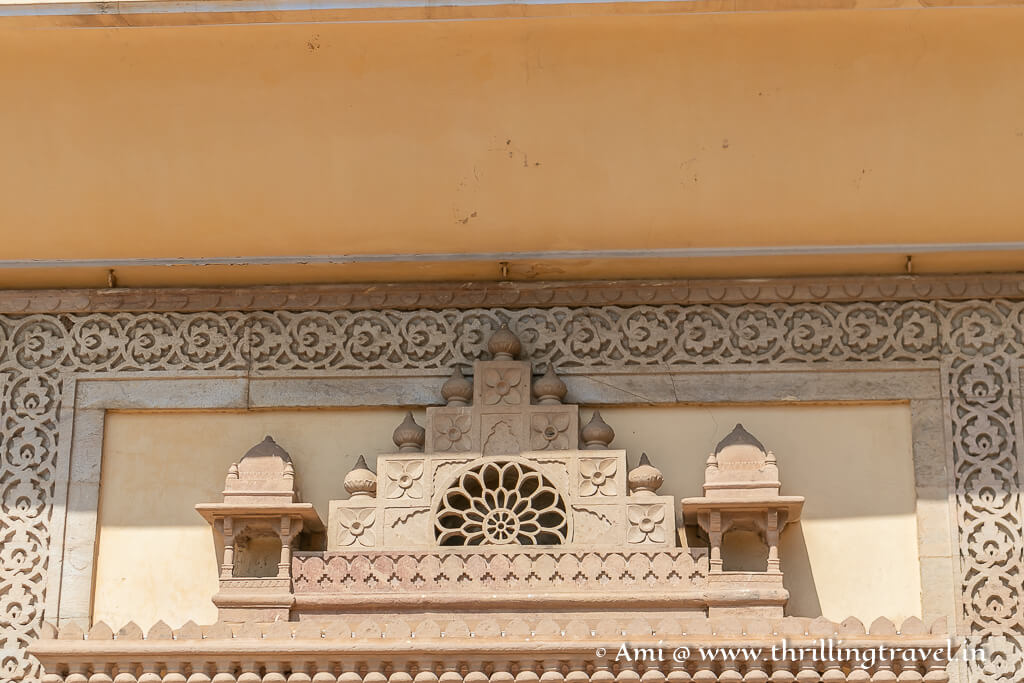
One of the key features of the Mubarak Mahal is that it is symmetrical in its design – quite like the Taj Mahal in Agra. However, what I loved about this palace was the beautiful fusion of designs from three different cultures – Mughal, Rajput and British. You can see the lovely arches with intricate designs that have been inspired by the Mughal palaces. The doorways and the pillars in this guest house showcase Rajput Hindu temple designs while the higher floors have the cross -shaped alignment usually seen in colonial buildings.
2) The Royal Clothes in the City Palace Museum Jaipur
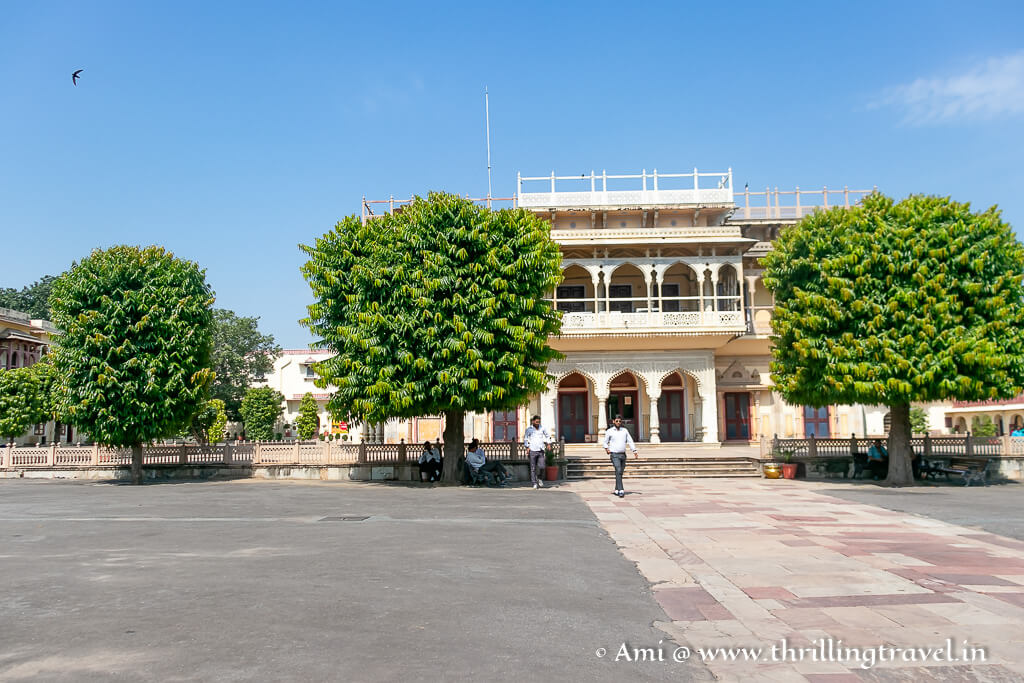
The Mubarak Mahal now houses a textile and handicrafts museum where you can see a display of the Royal wares and clothes. Unfortunately, I cannot treat you to any of the pictures as photography is not allowed here. There are some pretty interesting City Palace stories lurking among the exhibits.
Let’s start with the ostentatious dresses of the princesses and Queens that weighed 9 kgs. They were so heavy that she could not carry it herself and needed more than a maid to help. What was even more fascinating was that she could not walk with all that weight. So, a palanquin or a wheelchair was used to move around within the palace. I am not sure if I would have liked that!
The highlight of all the exhibits inside the Museum of City Palace Jaipur is the voluminous clothes worn by Maharaja Sawai Madho Singh I. Humungous may be the right term here for the clothes are 4 ft wide. Yes, you could say it was for a giant man weighing 250kgs. Seeing those clothes was quite a wonder – I think two of normal-sized humans would have fit into them. And if that has not popped open your mouth – here is one more astonishing fact. The Giant Maharaja had 108 wives!!! Like my hubby remarked – managing one is a task and over 100…GOSH!
3) Rajendra Pol – the gateway to the Royal palace
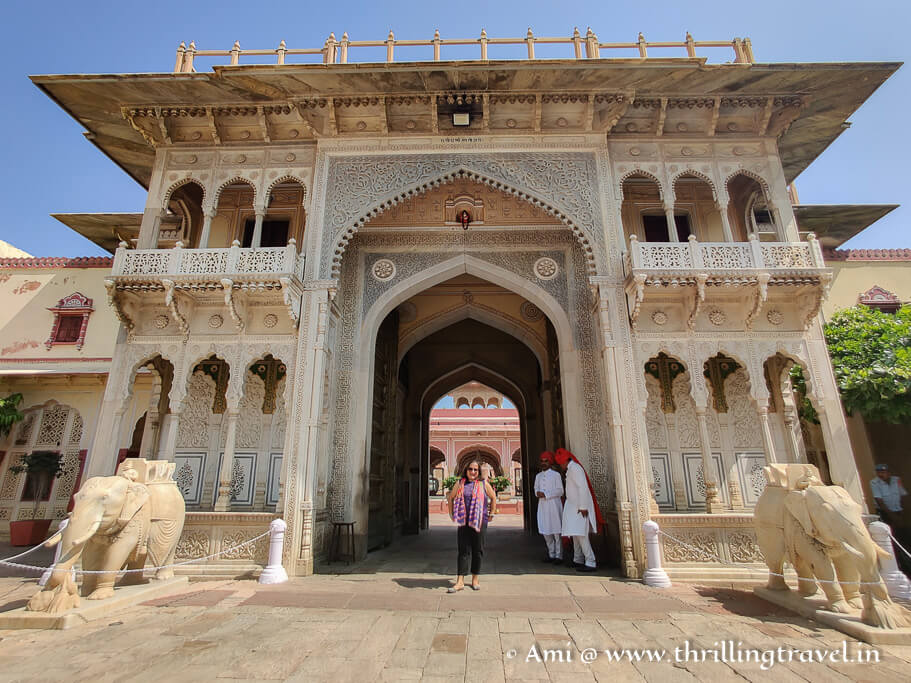
A gorgeous marble gate connects the Mubarak Mahal section to the royal court and residential section of the City Palace. Don’t dismiss it as just another picturesque gate. The marble used in this gate was brought from a place called Makrana in West Rajasthan – which is the same place that supplied marble for the famous Agra monument – Taj Mahal. Quite like what you might have seen at the Taj Mahal, there is stone inlay work along these marble walls.
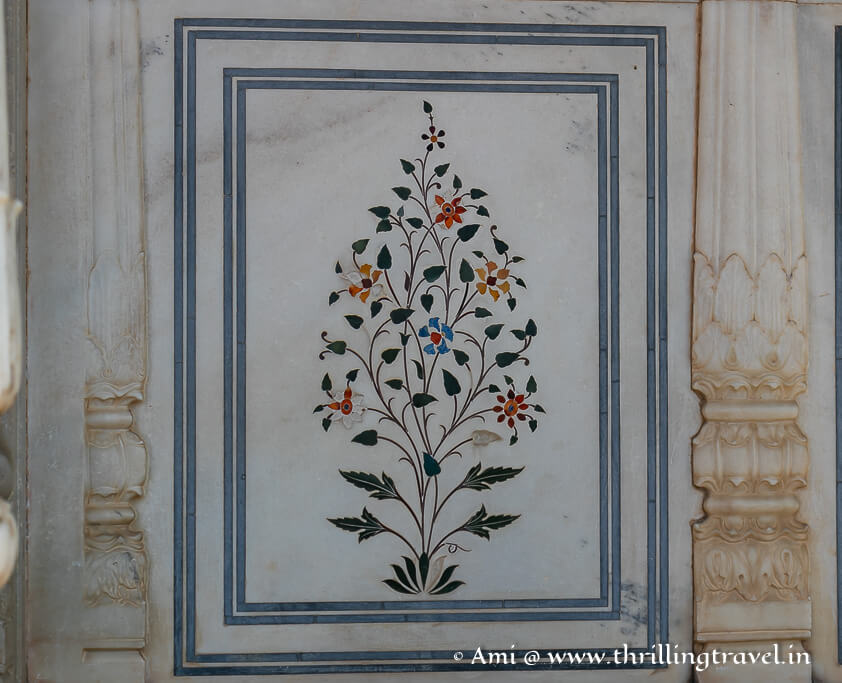

The other impressive feature here is the monolithic marble elephants kept on either side of the gate. The elephant with its Mahout is a stunning gate decor. There are always two guards near the gate. Dressed in their royal uniform, they are more than happy to complete a postcard picture with you – a memento of your visit to the Jaipur City Palace.
4) Gangajelies & Chandeliers of Diwan-I Khas
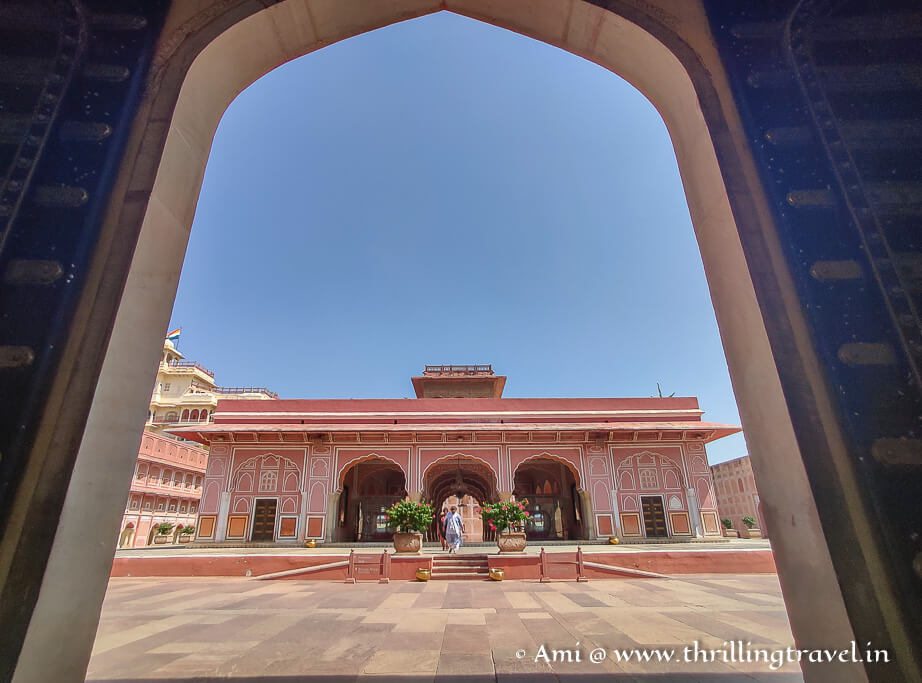
The first building that you can see from the Rajendra pol is the Diwan -i- Khas or the Hall of Private Audience. Right opposite the Chandra Mahal, this huge hall is full of impressive crystal Chandeliers. Diwan-i-Khas is more of a Mughal term. In the Jaipur City palace, this is called Sarvato Bhadra. The grand hall with its high ceilings, sparkling chandeliers and marble floors is quite an architectural gem.

The whole structure might seem like an open one but there are four closed rooms at each corner. The open area was covered with curtains in its heydays. This was the actual court of the king, the stronghold of his power.

The main hall was not just important back then. It is quite symbolic and important in today’s world too. This is the hall where major religious rituals and festivals take place. During Dusshera, Gangaur and Teej, the hall has a statue of the Goddess, who is decked and taken out in a procession through the city of Jaipur. It turns into an exhibition of kites used by the Maharaja himself during the festival of Makar Sankranti. However, the thing that will make you go WOW is yet to come!

The most interesting artifacts here are the Gangajelies or the water urns that carry Ganga water. 2 huge silver urns that are 5 feet high and weigh around 340 kgs are on display. Our guide told us that they are officially the biggest sterling silver urns in the world– and are a part of the Guinness Book of World Records. These urns were made for Maharaja Sawai Madho Singh II for his visit to London. The Maharaja would only drink Ganga Water and hence, 2 large silver urns with 4000 liters of water were packed for his visit to Britain. 🙂 Each of these silver flasks was made by melting 40,000 silver coins. The large size and this City palace story are what had me go WOW.
5) Chandra Mahal or the Moon Palace

The main residential palace is called the Moon Palace or the Chandra Mahal. The Palace is a 7-storied one, and some parts are still occupied by the Royal Family. A flag, larger than the regular flags flies atop this palace. The flag has five colors and there is an interesting story behind why this is the case. When Raja Man Singh I (ruler of Amer) served under Emperor Akbar, he had to travel to Persia as his commander-in-chief. In a single battle, he managed to acquire five different kingdoms. As this City Palace story goes, Raja Man Singh took the flag of each of these kingdoms and made it into his clan flag. Hence, it has five colors and is larger than the usual flags.
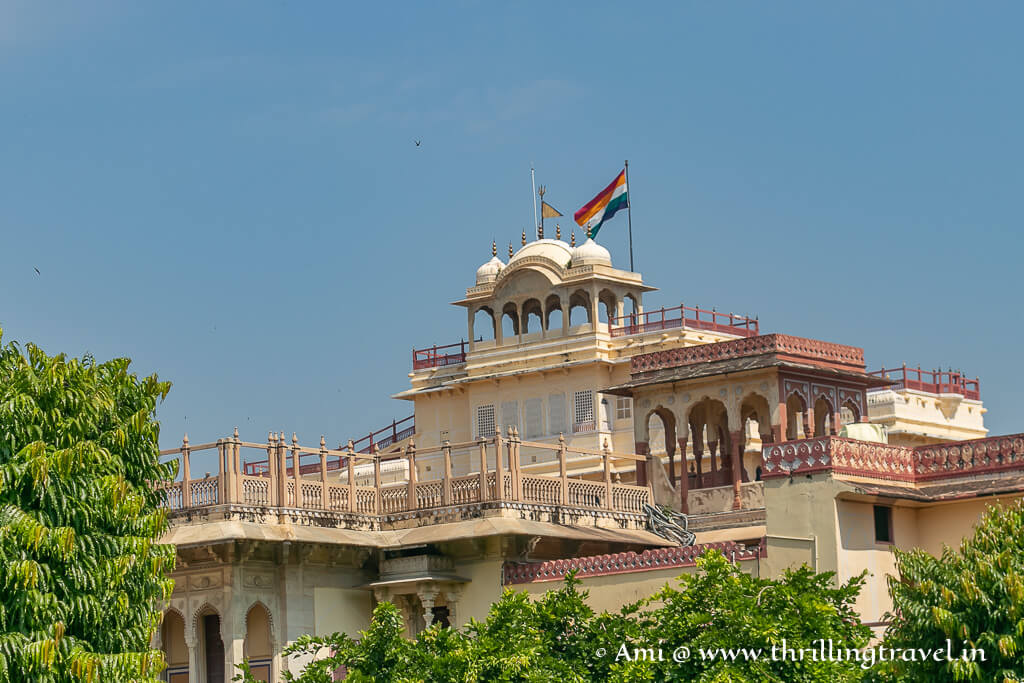
Besides this flag, pay attention to a smaller flag that has been given the name “Sawai” – meaning one and a quarter. Why so makes another interesting tale in this City Palace Jaipur.
Sawai was a title given by Aurangazeb to Maharaja Jai Singh during his wedding and was taken forth by the dynasty thereon. As the story goes, Aurangazeb was impressed with the witty quips of the young Maharaja Jai Singh and conferred the title – Sawai – someone who is one and a quarter. Since then, the name was adopted by the family and a smaller flag was added next to the five-colored one. Even today, it is unfurled when the Royal family is in residence.
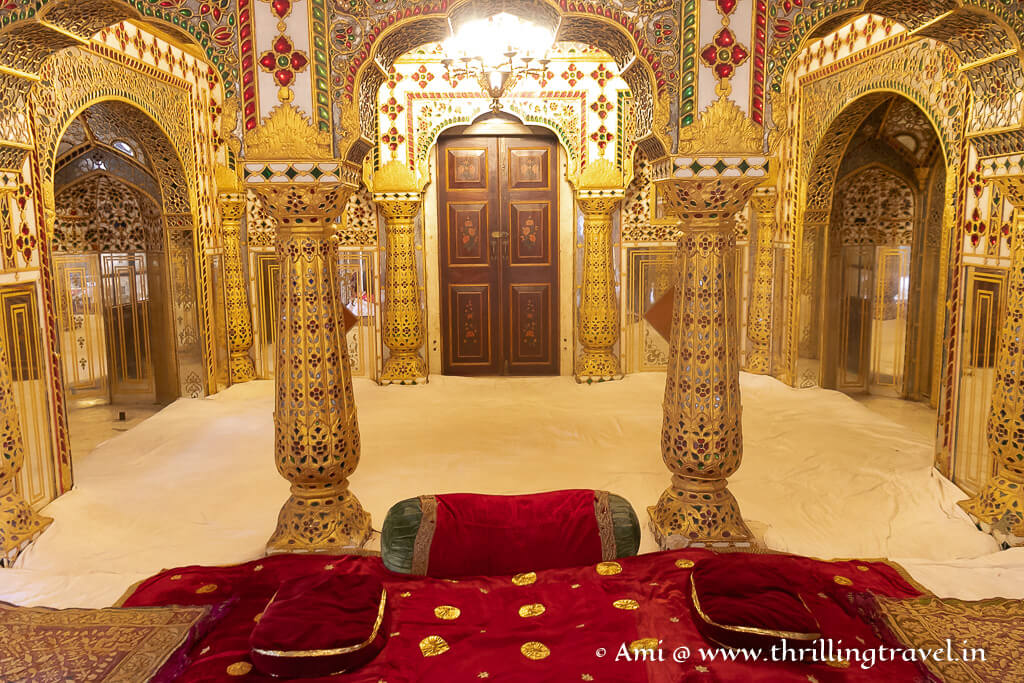
Today, only the ground floor is open to the public on the general tour. There is a special luxury tour that takes you to the upper echelons of the Chandra Mahal. Each of the floors has a unique name and has been built by a particular Maharaja.
- The second floor is called the Sukh Niwas after the wife of Maharaja Sawai Jai Singh
- Rang Mandir is the 3rd floor and is called so owing to its decor of mirrors and colors.
- Shobha Niwas is on the 4th floor of Chandra Mahal. This is where the king performed Laxmi Puja on the day of Diwali.
- Chavvi Niwas is on the 5th floor and has a decor of various images.
- The 6th floor is called the Shri Niwas
- The last and the 7th floor is called the Mukut Niwas. Mukut means crown and this is where the flags are hoisted. I believe, this is also, a place that gives a lovely view of the pink city.
There are plenty of treasures that these floors hold and I only managed to do the special royal tour during my 2nd visit. This tour deserves a post of its own that you can read here. However, even if your particular visit cannot accommodate this tour, I assure you that even exploring the ground floor will be the highlight of this entire City Palace Jaipur tour.
6) The portrait gallery of Jaipur City Palace
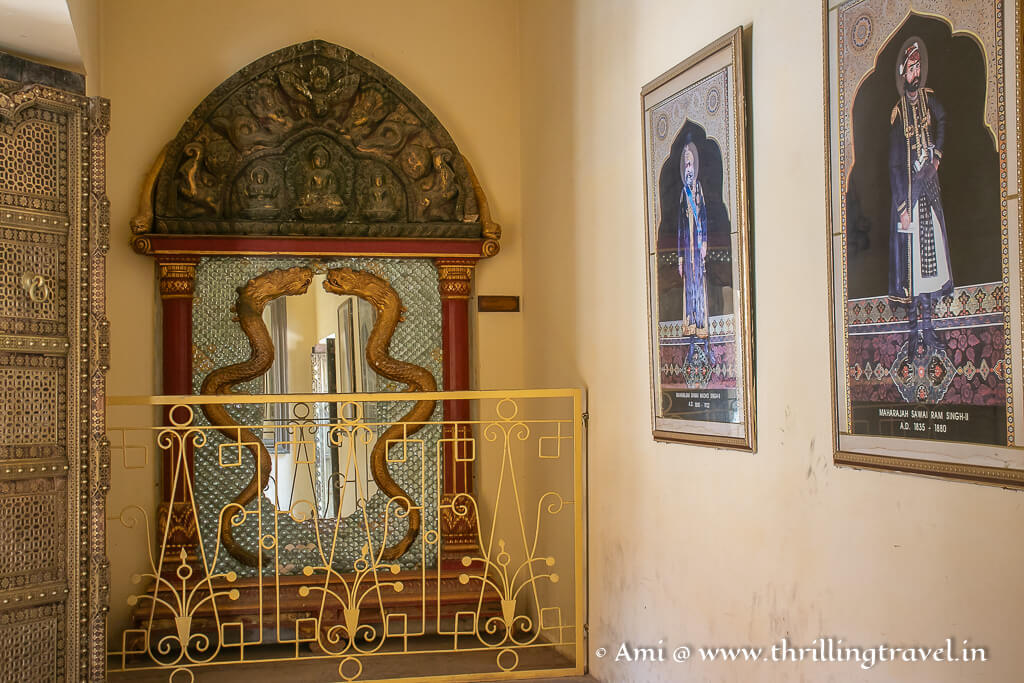
This is a small passage that you will follow when you enter Chandra Mahal and walk to the Pritam Niwas Chowk. The walls have paintings and pictures of the royal family of Jaipur. You can even see the current family picture with Princess Diya Singh (member of parliament) and the current Maharaja Padmanabh Singh who is in his twenties.
There is an exquisite door and a mirror too, at either end of the gallery.
7) Pritam Niwas Chowk
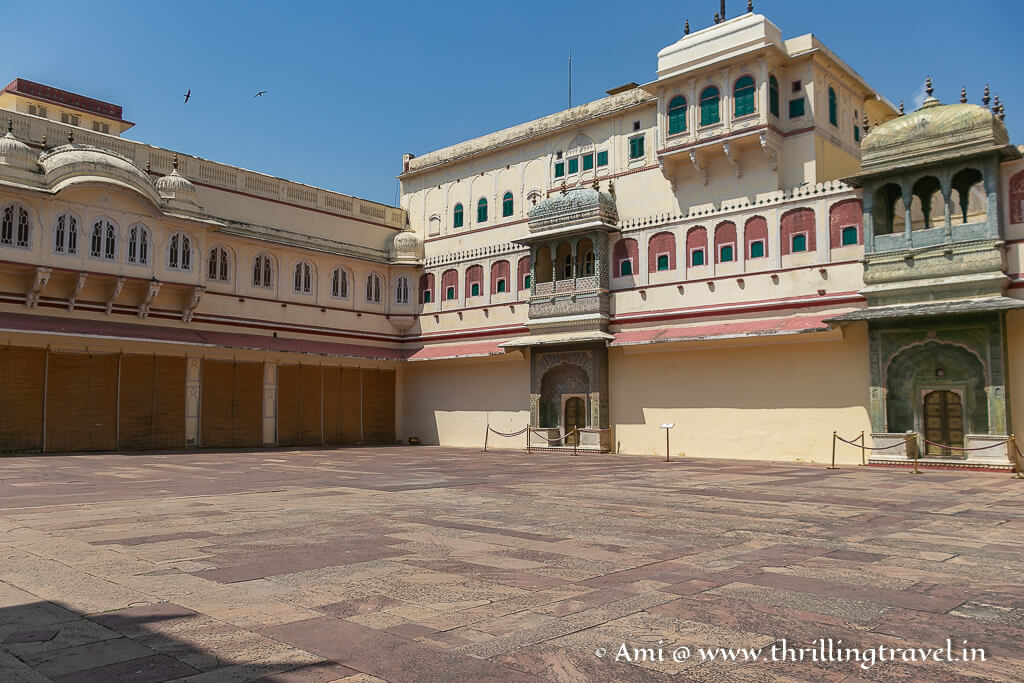
The Pritam Niwas Chowk is one of the unique Royal Courtyards that I have come across. Pritam Niwas Chowk means “courtyard of the beloved” and was extensively used by the Royal family for festive occasions and ceremonies. The women observed the proceedings from the jharokhas on the first floor. The most beautiful feature of it is the four gates of the City Palace Jaipur which have been designed based on the 4 Indian Seasons. Each one is dedicated to a particular Hindu Deity.
The gates would be opened for the performance based on the season. Let’s start with my favorite – The Mor or Peacock gate, which represents the Autumn season.
Peacock Gate or Mor Gate

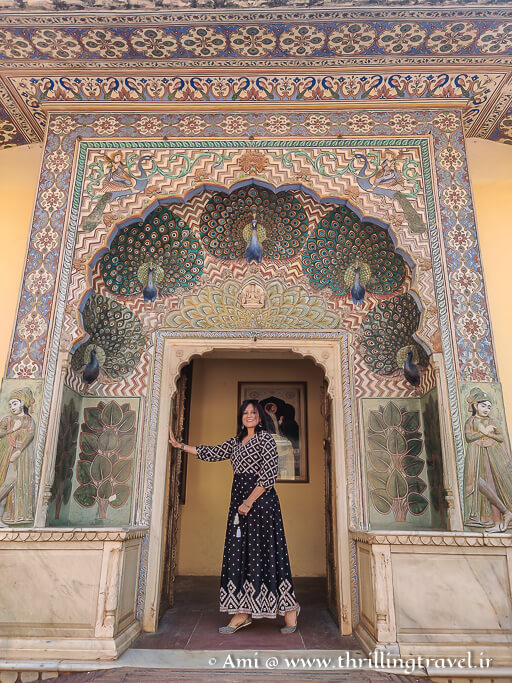


The gorgeous 3D models of peacocks made this a popular photography spot – so much so that we were not able to get one devoid of crowds. 🙁 Nonetheless, I managed to get a zoom-in of the peacocks on this gate. 😀 The gate is dedicated to Lord Vishnu.
Lotus Gate at City Palace Jaipur
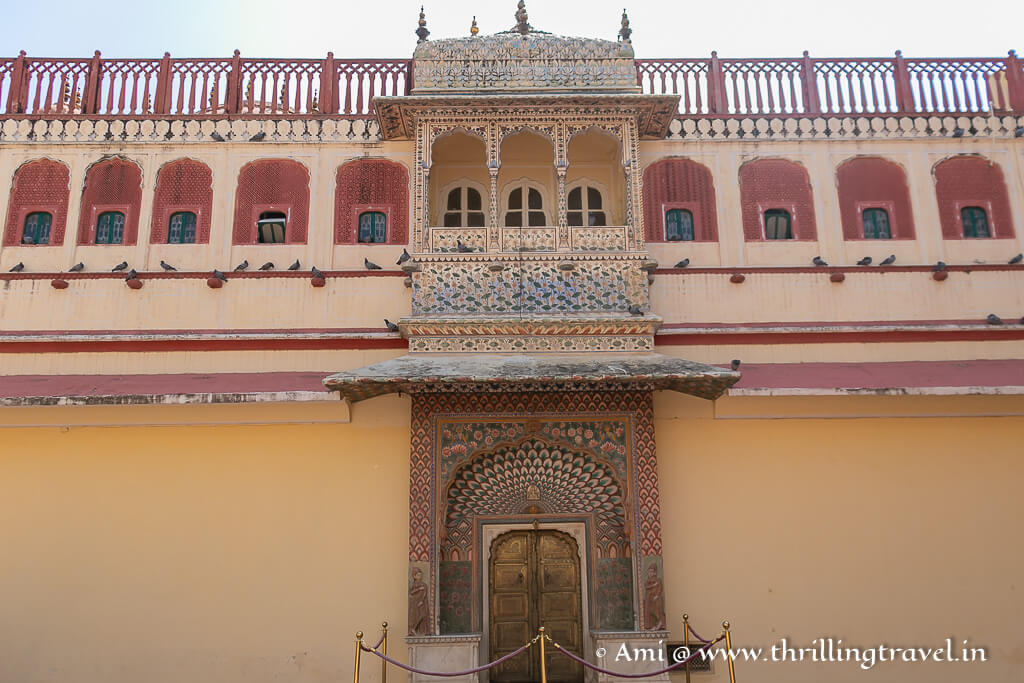

The next one is the Lotus Gate representative of the Summer season. The repetitive pattern of the Lotus petals is suggestive of the same. It faces the south-east and is dedicated to the heavenly couple – Lord Shiva and Goddess Parvati.
Leheriya Gate of Jaipur City Palace

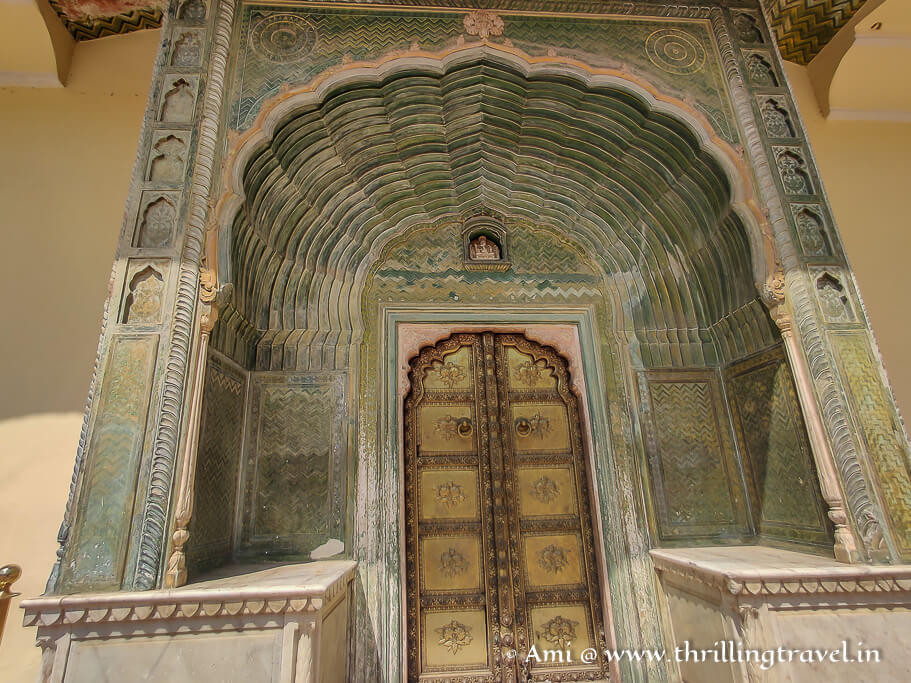
Dedicated to Lord Ganesha, this one has waves of green. The green gate or the Leheriya gate was done to showcase the greens of the Spring season.
Rose Gate of City Palace Jaipur


The winter gate or the Rose Gate was a soft pastel shade with delicate blooms to indicate this season. This gate appealed to my feminine nature and is dedicated to a Goddess. Loved the soft pastel shades on it.
For me, the uniqueness of this courtyard is what I will always remember City Palace Jaipur for. It is not every day that you get such instagrammable spots all in one place.
8) The Golden Throne at Diwan-I Aam
Diwan-I Aam or the Hall of Public Audience is another place within the palace, where photography is not permitted. Hence, devoid of pictures, I am hoping you can visualize this. Imagine a huge hall of red and gold, with a painted ceiling and an ornate carpet, ending at a golden throne.
It is this Golden throne or the Takhat E Rawal is one of the best things to see in City Palace Jaipur. Ornate as a throne should be, this was used not just as seating in the Public Hall but also, doubled up as a howdah on an elephant. Well, multi-purpose utility existed back then too, and that too, in the most royal manner as possible! 
Passages at City Palace, JaipurThe Diwan-i-Aam are called the Sabha Niwas in the City Palace Jaipur. While the King presided over the main throne, the women of the palace oversaw the proceedings behind the jhalis or curtains of the first floor. This was also, the place where family ceremonies like coronations were held.
Besides these highlights, you are bound to spot several other interesting things within the palace-like these gorgeous hallways. Like the miniature paintings exhibited in the gallery. Keep an eye out for the rare Bhagwat Geeta in these exhibits. It is handwritten and small enough to be hidden from the eyes of the invaders.

While these are just are the bigger of the things to see at the City Palace Jaipur, they aren’t the only ones. There is a Baggi Khana with its various chariots and buggies. Also, pay a visit to the Royal Govind Devji Temple. And yes, you cannot miss the old Clock tower just behind the Diwan-i-Aam. The clock was added to the tower later on to an existing tower. It is an 1873 one and still works.

Shopping at City Palace Jaipur
Before you exit the City Palace in Jaipur, you will come across a small shopping area that is called the Museum shop or the Palace atelier. where you can buy Jaipuri bedsheets, pashmina shawls, gemstones as well as local dresses. Most guides in City Palace will urge you to have a look, if not buy. The products here are made locally using genuine material and the prices I found, are quite reasonable. On both my visits, I ended up buying some of these products. In fact, the Pashmina shawl that I bought here has survived many of my travel trips and is my favorite. I even, ended up picking a new one this time when I visited again.
So, if you are looking for authentic articles from Jaipur, I highly recommend shopping in City Palace Jaipur. The proceeds of these sales goes to support the local NGOs including the Princess Diya Kumari Foundation which supports rural women. In some ways, you will be contributing towards some sustainable tourism. The shops also, offer to courier your articles anywhere in India – and yes, they do arrive.
I am sure you will find your own gems that make you go WOW at the City Palace. Check the next section of this City Palace Jaipur guide for some practical tips and don’t forget to pin the post to your board – as a reminder to share what are your WOW factors at the Jaipur City Palace.
Common FAQs section of this City Palace Jaipur Guide
What is the best way to reach the City Palace in Jaipur?
Jaipur City is very well connected by air, rail and road to all the major cities of India. Part of the Golden triangle, it is possible to even do day trips to Jaipur from Delhi and Agra. The City Palace is located conveniently in the center of Jaipur and you can easily get to it by car or by hiring one of the autos or e-rickshaws.
What is the best time to visit City Palace Jaipur?
In terms of the season, Jaipur is best visited between October to March. Summers are extreme here with temperatures soaring to over 50 degrees and monsoons can get heavy. Avoid visiting the City Palace on weekends as it really gets crowded.
In terms of the day part, City Palace can be visited any time. Most of the places to see inside City Palace offer you adequate shade. If you are a photographer, avoid the overhead noon sun between 12 and 3 pm.
What are the City Palace Jaipur ticket prices?
The regular City Palace Jaipur tickets cost INR 300 per adult for Indians and INR 700 for foreign nationals. However, you also, have the option of purchasing composite tickets that include other Jaipur city attractions like the Hawa Mahal, Jantar Mantar, Amer Fort, Jaigarh Fort, Albert Hall Museum and even Sisodiya Rani Gardens. The composite ticket is valid for three days and costs INR 400 for Indians and INR 1000 for foreign nationals.
There are two other special tours called the Royal Grandeur tour and the Royal Splendour tour that takes you to the restricted areas inside Chandra Mahal. These cost INR 1500 and INR 3000 for Indians while foreigners can buy these tickets for INR 2000 and INR 4000 respectively. They include a guide as well as refreshments. These tours may not be available on certain days if there is a festival or a family function.
This is the official website of the City Palace, Jaipur. All information on the ticket charges, the audio guides and visiting hours are documented on it.
What are the City Palace Jaipur timings?
City Palace Jaipur is open from 9:30 a.m. to 5 p.m. on all days
What are the other places to visit near City Palace Jaipur?
Here is a list of places near City Palace Jaipur that you can club with your visit here
– Hawa Mahal
– Jantar Mantar
– Govind Nath temple
– Tripolia bazaar
– Bapu bazaar
Which is the best gate to enter Jaipur City Palace?
I personally recommend entering the City Palace of Jaipur through Virendra Pol, which is opposite Jantar Mantar and exiting through Udai Pol, which is near the parking area of City Palace. That way you can finish Jantar Mantar first, then the City Palace, shop in the museum shop and finally exit.
Why is Jaipur City named so?
Jaipur city was named after Maharaja Jai Singh II who built the City Palace here.
Should you hire a guide in City Palace of Jaipur?
I highly recommend hiring a guide or at least opting for one of the audio guides.
The audio guides are available in 4 languages – English, Hindi, French and German. The regular guides here are well-trained and can speak other languages as well. Hence, do enquire about the same at the entrance of the palace.
How much time is needed for Jaipur City Palace?
For a regular tour of City Palace, you will need at least 2 hours. If you are opting for one of the royal tours, keep aside at least 3 hours.
Is there parking available near City Palace Jaipur?
There is paid parking for visitors to City Palace in Jaipur. This is in Jaleb Chowk, near the Udai Pol gate.
Miscellaneous Travel Tips for City Palace Jaipur :
- Flat shoes are recommended for the sheer amount of walking to be done.
- Food is available at the Palace Cafe. There are restroom facilities as well.
Before you go, pin This




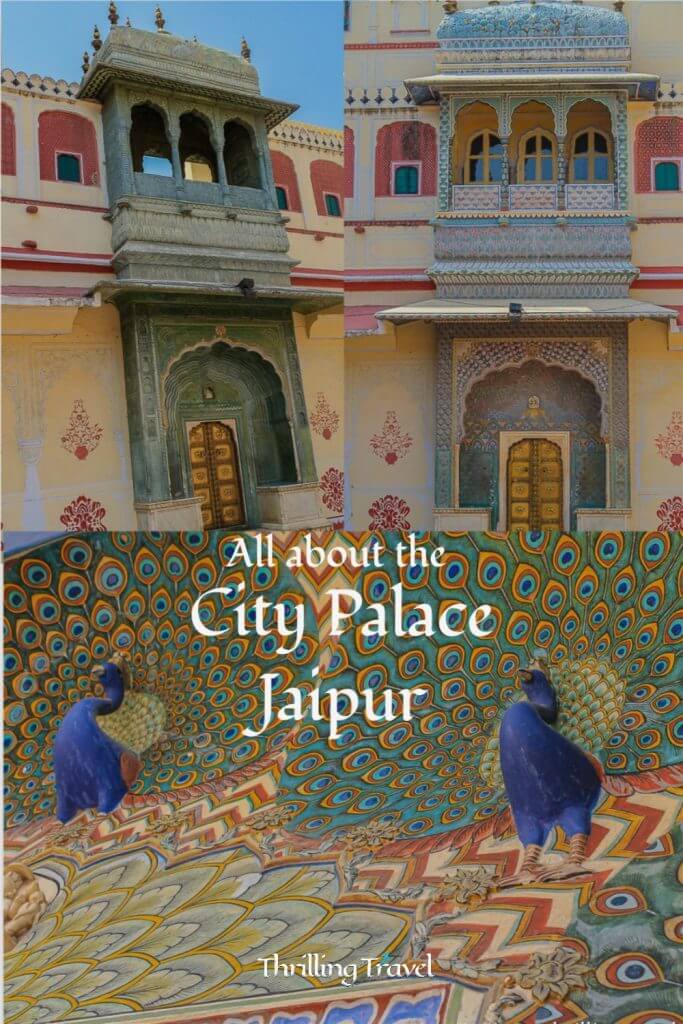
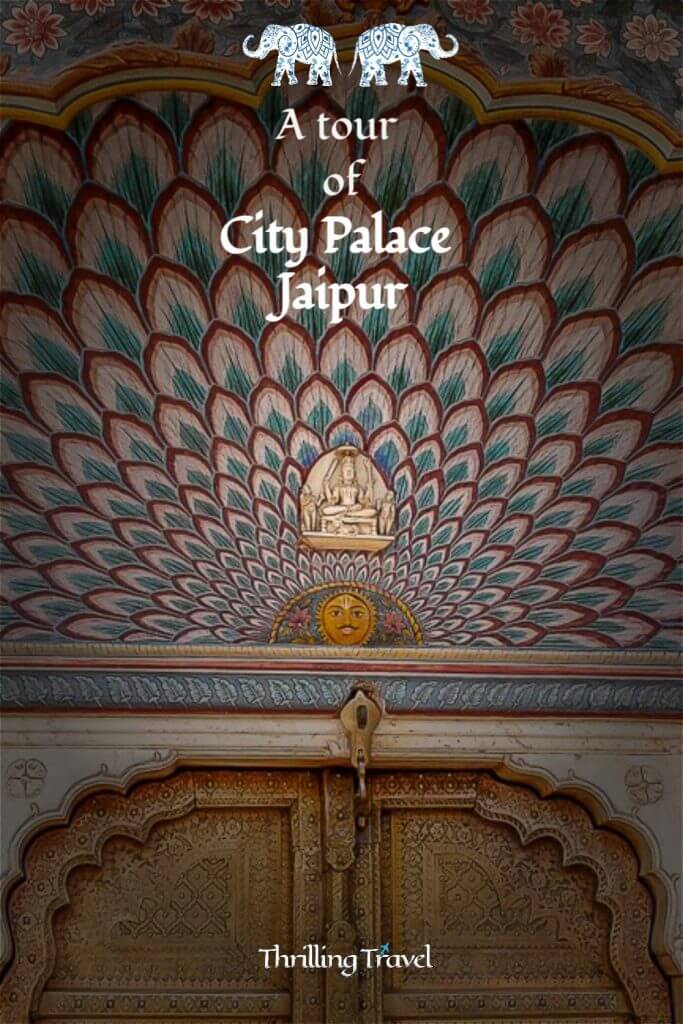
Popularly referred to as a Restless Ball of Energy. My Mom refuses to entertain my complaints about my equally restless daughter & assures my husband that I was born with a travel bug.
I am a Post-Graduate in Marketing by qualification and a travel blogger by passion. Besides travel, I enjoy photography and if you don’t find me at my desk, I would be out playing badminton or swimming or just running. I believe in planning for every long weekend through the year. And when I cannot travel physically, I travel virtually through this travel blog. My travel stories have also, got published on various websites and magazines including BBC Travel, Lonely Planet India and Jetwings. I have recently published my first book – When Places Come Alive – a collection of stories that are based on legends, landscapes, art and culture of a place which is available in both ebook and paperback format.
You might also like these posts –
- Jaipur City Palace Royal Tour: Experience the Grandeur of Royalty
- How to plan a trip from Delhi to Jaipur by road?
- Inside the Palace of Winds: A Guide to Hawa Mahal Jaipur
- How to enjoy a Sunrise at Taj Mahal? – What to expect, tips & tricks
- My lovely yet incomplete tour of Amer fort Jaipur
- Tour of the Jantar Mantar in Jaipur
- 10 travel tips for Rajasthan
- The intriguing Jal Mahal in Jaipur
- Sisodia Rani Bagh: A royal tryst with nature
- Secrets of the Jaigarh Fort in Jaipur
- Best areas to pick hotels in Jaipur
- Places to see in Jaipur over 3 days

Nice article on beautiful and royal Jaipur, one of India's most historic cities. Nice photos too.
Magnanimous is the word.. 🙂
Thank you. Glad you liked it
Thank you
Palace looks beautiful. The peacock pic was so colorful.
What majestic architecture and intricate carvings… 🙂 Loved it!
Jaipur is my hometown. I have seen this place several times but your style of narration has such a novelty that it feels as if I am exploring a new place. Great piece Ami.
Beautiful pictures and a great post as always!
have many more adventures travelling and keep sharing with us 🙂
I have seen some incredible shots of India, but I've never seen such fascinating art. The peacocks and lotus door really caught me off guard and are some of the most striking things I've seen.
I was in India years ago but unfortunately missed Jaipur: I remember being torn about it and eventually skipped it – now I wish I didn't, it looks so beautiful and interesting
Awesome clicks Ami and lovely post…
xo, Neha
https://www.theinstylejournal.com
Your family pic is awesome sweetie… and I loveee Jaipur… there's so much to do… but the best thing is… SHOPPING!!! yay!! following you now.. finally!!! hugsies 😉
The colors and the architecture are amazing, this destination looks beautiful thanks for letting us know about it
Those buildings are really amazing. I love the details of the decoration and architecture. Just beautiful
Jaipur's architecture always makes me go WOW. Those peacocks are my fave! So pretty <3
Nice guide to Jaipur. Though, I've been there I must have missed a few of these places. Would surely remember to visit them next time. Nice photographs too!
Thank you Arun. The peacock gate is my favorite 😀
Thank you Maniparna.
Thank you so much. Am glad you liked it.
Thank you Hargun. 😀 Stay tuned for more.
They sure are Rob and Chris. I found them mind-blowing.
Oh Marta. You must make a trip back here and visit the whole of Rajasthan. Am sure you will love it.
Thank you Neha
Shopping is fun alright. Loads of stuff to carry back home. Though this time, I could not indulge much. Keeping it for another visit.
Thank you. The destination indeed is lovely.
Thank you. Glad you enjoyed the tour 😀
Mine too…loved the peacocks. Cheers
Thank you Kishor. Do share your experience when you make a trip there. Cheers
Great pictures that really showcase the great architecture! Beautiful colors and designs!
My visit there was a hurried one. I plan to make one more trip there. I can see what all I have missed. 🙂
Thank you …loved the place for its colorful ambience
Hey Indrani….take me with you again…would want to do the Royal Grandeur trip 😉
I remember the ornate doors most vividly. Been there more than once! Loved the pictures.
Loved your images Ami. Specially the 3d models of peacocks, rose gate and lotus gate are phenomenal.
Beautiful tour of magnificent city palace.
Very phenomenal place and the sad part is that I haven't been there. Time to travel? 😉
Thanks Mridula. The gates indeed are memorable
Thank you so much
Thank you Rajesh
🙂 Happens to the best of us Nisha…Time is always short. Hope my virtual tour made up for some disappointment 🙂
City Palace in Jaipur is not to be missed. You seemed to have made most out of your trip, Ami. Looking at your pictures, it seems it was all fun!
Good article gives a clear picture of City palace. Article what to shoot and how to click also. In travel tips things to be added.
1. Take plenty of water along with you.
2. Food at BARADARI is too costly more than star hotel rates. This is for foreigners. So carry some food along with you. One can not enjoy food at BARADARI.
3. The best thing is taking Audio guide. Follow the map.
Thanks Dinakar. I am sure my readers will benefit from these tips.
I’m yet to head to Jaipur and I’m sure I need a few days just to explore Jaipur itself!
Ofcourse the top priority would be Hawa Mahal and Jantar Mantar.
The 4 types of gates at Pritam Nivas Chowk looks absolutely splendid. My fav is definitely that peacock gate!
I really need to plan soon for my trip to Jaipur.
I am sure that you will love the colors there. It is so artistic.
Japiur has been on my list to visit in India for a very long time and I can’t wait to head out there. I know some of the palaces and temples (I think there is a temple dedicated to rats here if I am right) but you have shown that there is a heck of a lot more to the city than I first thought. As an photographer and lover of different building styles, it looks like I need quite a bit of time to really appericate Jaipur. I love the fact there are so many pretty colours and art designs on the facades of buildings which really does ligthen up the place as well as the statues to go along with this.
The temple for the rats is closer to Bikaner. I have been there and you should check out my experience on the same. AS for Jaipur, there is no missing out on the colors and the art around.
Wow such beautiful pictures. They made me relive my memories of our visit to the City Palace complex. Such a wonderful place to spend time marveling at the architecture. Rajasthan will always remain special for me having done my college and university education from there. And Jaipur of course having visited umpteen times.
No matter how many times you get to Rajasthan, you will love it. Glad that I refreshed your memories.
I haven’t been to India and know nothing of the area. You provided so much information I feel like I wouldn’t need a tour! The moon palace and Pritam Niwas Chowkare gorgeous! I could spend hours exploring the architecture alone
Thank you for the lovely compliment. I am sure you will now know a lot more when you do get there but I still recommend a tour guide , its hard sometimes to locate things 😀
Hawa Mahal evaded me, others all done. But I am keen to get there again. Those doors with peacock designs are mesmerizing, especially the 3D ones! Such creativity! I was surprised at the Bengali Babu’s involvement in designing this place! Brilliant work by the team.
Oh you must do the Hawa Mahal. It is quite stunning from the inside. Glad you did the city palace though
Wow, 🙂 the City Palace is stunning. Painting the city pink was a nice tribute to King Edward VII. Bummer that they don’t allow photos in the Royal Clothes Museum but it makes sense.
Photos or not, that museum is just fun. Hope you can see it for yourself.
I have only went to Udaipur and not to Jaipur during my Rajasthan trip. Being Jaipur a Pink city, I have read and seen so many beautiful pictures of splendid palaces of Jaipur. I loved the arches of Mubarak Mahal, as they look so intricate and well sculpted. Also the Mor gate or peacock styled gate is really wonderful and photogenic here. Lehriya gate is also another masterpiece here. Thanks for sharing wonderful palaces and also their key features in this post.
Udaipur personally, is my favorite. But Jaipur is not far behind. I do hope you get a chance to visit it sometime. Cheers
It’s good to know that the architecture of City Palace has a bengali connection, makes me feel connected already .. this peacock chowk apparently attracts so many tourist , thanks to the social media but defnitely there are so many pretty sights other than just Hawa Mahal or just the peacock chowk . Infact the food out there I heard is amazing . Your detailed guide on Jaipur will definitely help travellers plan few more days in Jaipur while planning their Rajasthan trip and not just a stop over . Great post .
I frankly would not have realized the Bengali connection had it not been for the guide. The palace is such a fusion of styles that it is hard not to pin point at who could have been the architect. Thanks for the lovely comment.
I love Jaipur and have been to this city countless times. And, still, the Hawa Mahal has eluded me for long. Those peacock gates are a sheer riot of colours and so does the whole of the Jaipur Palace. YOu have captured some wonderful photographs there, Ami !
Thanks for stopping by Meenakshi. It is a pity you missed Hawa Mahal. I hope you can get to it the next time. Its gorgeous. And yes, maybe a second trip to City Palace
Again a great content is written by you, Ami. I’m an avid reader of your blog. I read your blog just because they look authentic. Blogs’ structure is great too and in-depth guide.
Thank you Ravi. That is a lovely compliment.